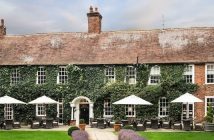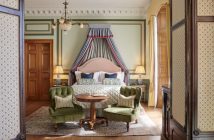Even taking into account that prettiness is a criterion for any Cotswolds village, Woodstock is surely the sublime expression of the honey-stone idyll. It’s not just the perfect, sash-windowed high street, with its profusion of picturesque tearooms or its inordinate number of pubs with roaring fires that could all compete for a place in any country’s cosiest inn competition. No, it is that at the end of the charming scene, lies something altogether grander, a punctuation mark to the village of such majesty that the visitor suddenly realises that the main artery of Woodstock is, in effect, the most lavish driveway to arguably the most lavish home in the land: Blenheim Palace.
Poking around stately homes is a national pastime so prevalent in the over 35s that it ranks alongside bemoaning the weather, listening to Radio 4 and downing industrial amounts of tea for sheer Britishness. And for enthusiasts, Blenheim Palace surely ranks as one of the country’s very finest examples – the more so for not actually belonging to the Crown, despite its titular palatial credentials.

The monolithic power of its façade, the sweep of its long drive and the spectacular setting within its estate, overlooking a 40-acre lake created by the mighty landscape genius, Capability Brown, provide all the constituent parts of a national treasure, which is fitting on two counts; first, that its status as a world heritage site makes any such claims official.
And second, that it is the birthplace of another – perhaps the greatest ever – national treasure: Winston Churchill, who made his arrival in the world, two months early, on a November night in 1874 in a room off the great hall where his mother, Jennie, had been dancing hours earlier. The wartime prime minister and prolific utterer of the pithy remark said of his birthplace: “At Blenheim I took two very important decisions; to be born and to marry. I am content with the decision I took on both occasions.”

Conceived on the grandest of scales in 1705 by talented architect John Vanbrugh, the famously imposing façade is a rare example of the lesser-seen, and notably severe, English Baroque style. Its great masses of stone are best viewed from a distance – a deliberate design feature since, in the 18th-century, the architectural emphasis in grand country houses was to create an impression of strength and power. Duly, as you approach the central Great Court, where three blocks of the seven-acre building come together, dotted with pillars and pilasters, the effect is to make one feel very small indeed. And as the festive season approaches, there is nowhere quite like it; visitors can sit for hours in the estate’s private chapel, listening to carols piping out, only to emerge to see Blenheim’s central courtyard lit up by twinkling lights. It is magic.
Afterwards, visitors can and should repair to the village, which boasts two charming, luxurious and pleasingly idiosyncratic hotels. We opt for The Bear, a coaching inn which dates from the 13th-century, with additions in the form of now-converted stables. Indeed the hotel does an excellent line in repurposed buildings; the reception (across the courtyard from the main hotel) is housed within a former glove workshop. But despite that it was once used for less grand pursuits than the residents of Blenheim would have bothered themselves with, today it is all luxury and sublime comfort. Characterful and cosy, its profusion of beams, tartan furniture and roaring fires make it the ideal place for weary Blenheim wanderers to slump contentedly.

We are shown, up a sweeping and centuries-old staircase, to our suite, named Oliver Cromwell, after that famous republican who reputedly stayed at Woodstock during the siege of Woodstock Manor in 1646. Other suites are named after equally prominent figures with connections to the village, chief among them, of course, Winston Churchill, portraits of whom are dotted about the place.
Had Cromwell been a more convivial man, he would doubtless have been impressed, as we were, with the enormous bed clad in Egyptian cotton sheets and the stateliness of the beautiful room named after him. Its sash windows look across to the high street, and heavy chintz curtains along with the beautifully appointed (with Arran Apothecary products and a lovely deep bath) large bathroom feel luxurious. And thanks to its Nespresso machine and complementary bottled water, we feel well-watered and well-looked after, as does our toddler, whose large cot is ready and waiting upon arrival.

On account of the presence of said young wildling, we opt not for the reasonably formal restaurant and instead explore the town’s more relaxed options (pizza in the pub). But at breakfast, we wolf down a sensational full English, all of whose constituent parts are locally sourced and of exceptional quality.
Parting is, as ever, such sweet sorrow when the time comes to make our way back to London via Oxford (which is a mere 20 minutes’ from Woodstock). But the regret at leaving is at least in part assuaged by jumping on a first class carriage of one of Great Western Railway’s new trains. It is quick, quiet, comfortable – and we’re the sorts whose spirits are always buoyed by having biscuits and coffee bestowed upon us.
Churchill himself would have approved – even if he’d have made his a large gin and tonic.
Advance single fares between Paddington and Oxford are available from £5.40 each way. For the best value tickets buy before you board at www.gwr.com. For more information about Blenheim Palace, visit www.blenheimpalace.com.
The Bear, Park Street, Oxfordshire OX20 ISZ. Tel 0344 879 9143. For more information, including details of offers, and Christmas and wedding packages, visit www.macdonaldhotels.co.uk.




